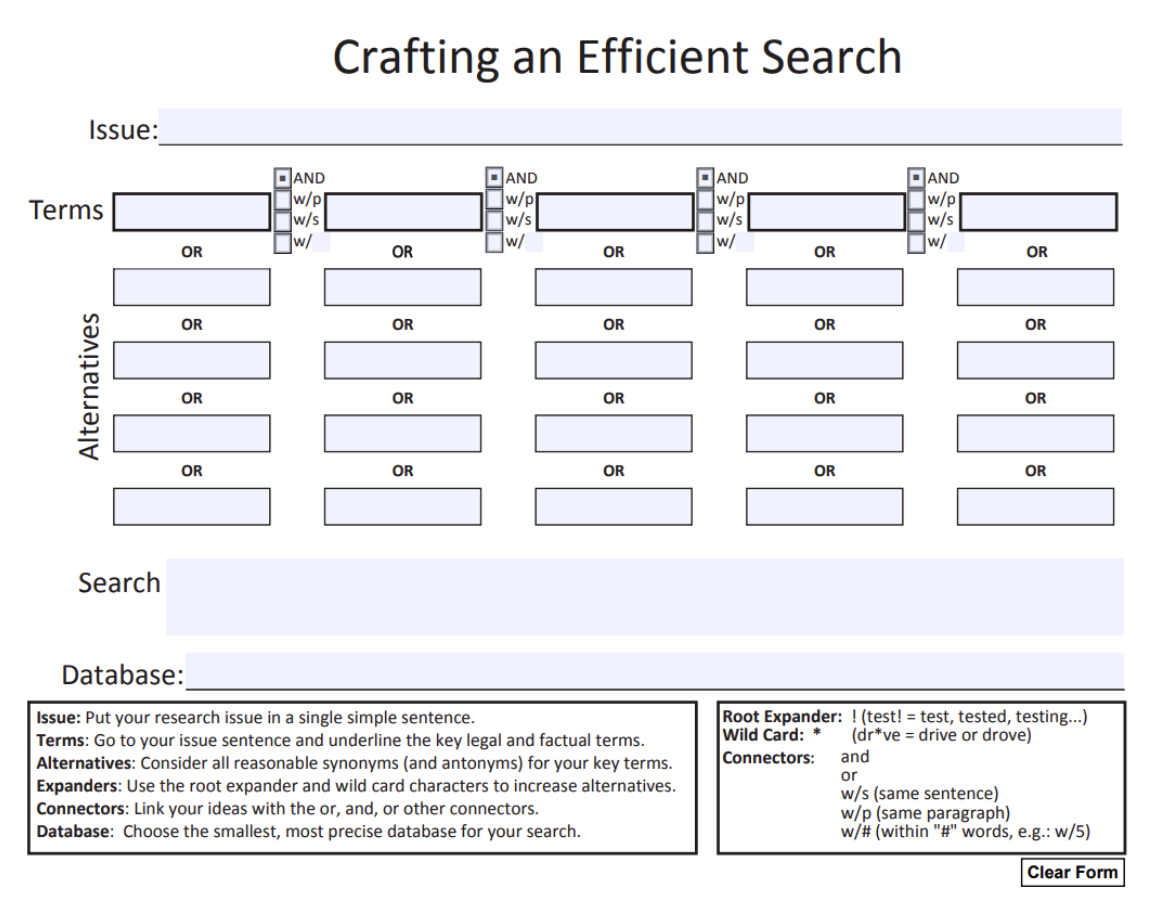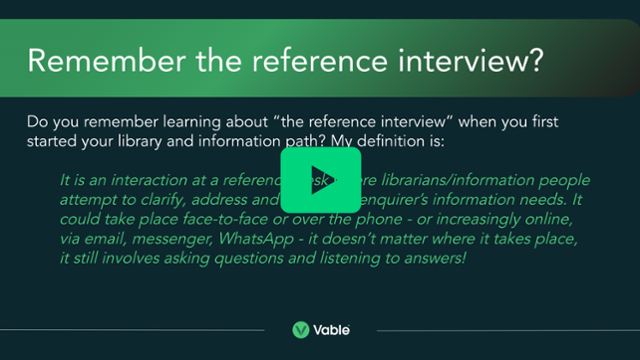Share this
How can we use the classic library reference interview to create the best newsletters?
August 30, 2023

Client satisfaction is a priority for Team Vable and we are proud when our clients recognise our efforts - after all, you as library and information people are also striving for excellence.
One of the most positive experiences we’ve had with Vable has been the customer service. If we face challenges, need help, or have questions there is always someone to assist us.
Part of Vable's success lies in our team’s ability to listen carefully to clients. Whilst we listen, we ask clients to expand, clarify and explain - asking the right questions is essential! With that in mind, I’ve been thinking about the library and information concept of “the reference interview" generally, and in relation to newsletter building more specifically.
Why taking the time to ask questions is crucial
Taking time to listen to your end users is important. As a library and information person, you can never have too much information about your end users' needs; that is to say, you need context for their situation so you can answer their questions in a meaningful and intentional way. A lack of information often means making assumptions, which can be wrong.
However, the most important reason to ask the right question is time. We are all familiar with the cliche about “spending money to make money”, but what about spending time to save time? An article from the HBR made it clear that we should spend more time asking questions;
Because expectations for decision-making have gone from “get it done soon” to “get it done now” to “it should have been done yesterday,” we tend to jump to conclusions instead of asking more questions. And the unfortunate side effect of not asking enough questions is poor decision-making. That’s why it’s imperative that we slow down and take the time to ask more — and better — questions. At best, we’ll arrive at better conclusions. At worst, we’ll avoid a lot of rework later on.
Finally, from a simple communications point of view, asking each other questions is a win-win because it shows you are listening and trying to understand, which helps build trust, engagement and buy-in.
Intuition and insight never go out of fashion
Do you remember learning about “the reference interview”? It is that classic interaction at a reference desk where librarians/information people attempt to clarify, address and deliver an enquirer’s information needs. It could take place face-to-face or over the phone - or increasingly online, via email, messenger, WhatsApp - it doesn’t matter where it takes place, it still involves asking questions and listening to answers!
Eminent librarians have written extensively about the continued need for a reference interview and Wikipedia offers us a handy summary of how we should view the process:
- Approachability: Setting the tone right.
- Interest: Showing genuine curiosity.
- Active Listening: Really hearing them out.
- Insightful Interviewing: Digging deeper.
- Strategic Searching: Finding the right resources.
- Providing Answers: Meeting the user's need.
- Follow-up: Ensuring satisfaction and closure.
(From Conducting the Reference Interview, 2019)
As we know - from our professional experience - there is always more to this interview than someone simply asking for something. The whole interaction is key; from the initial greeting to the final follow-up. The questions throughout the interview need to be thoughtful, open, and responsive. Our end users perhaps won’t necessarily appreciate our thoroughness at the time, but they will value the information outcome.
What happens when we aren’t interacting face-to-face, or are away from a physical library space? Many aspects of communication are lost but this quote inspires confidence that we are able to adapt and communicate our needs effectively, regardless of where the interaction is taking place;
Marie L Radford (2006) identified “relational facilitators” and “relational barriers” by analysing live chat transcripts. She defined relational facilitators as interpersonal aspects of the chat conversation that have a positive impact on the reference interactions. These included a hello message used as a greeting; rapport-building, including humour, reassurance, and inclusion; showing deference and respect; the use of text characters such as emoticons to compensate for missing nonverbal cues; and a closing ritual including a follow-up inviting the user to return, if necessary. [Conducting the Reference Interview, 2019]
How does this work in practice?
We are always trying to improve our workflows to improve efficiency and make life easier for our end users. If we have an electronic proforma/template with all the questions we need to ask, we can save everyone a lot of time - but you still need to include the appropriate relational facilitators. 👋
What type of questions should we ask users when we are creating their newsletters? We face a number of unknowns that we need to ask about before creating anything on a current awareness platform - lack of face-to-face interaction, lack of context, lack of time, lack of keywords and lack of source expertise!
When crafting a newsletter, it's not just about content curation; it's about organizing and presenting that content in a way that's digestible and relevant to your target audience. To bridge the gap between information and its recipients, information/knowledge people must consider a structured approach, one that caters to the ever-evolving needs of their audience.
Team Vable devised a simple template that serves as a guide to creating newsletters. For those using the Vable platform, this will be particularly useful - what follows are questions I always ask before starting work on a newsletter.
Strategic interviewing to build an end users's Alert or Newsletter
It is best to split this into two main sections.
1. The Alert or Newsletter
Are you really listening to your end user, and showing genuine curiosity as to why they need this newsletter?
What is its primary purpose? Who are the end users and what are their roles? Will this be set up as an Automated Alert (publishing at set intervals without Administrator intervention) or as a Curated Newsletter (for complete control and review of the contents before manual publish)?
2. The content of the Alert or Newsletter
The answers to these initial questions regarding the purpose of the newsletter will enable you to start digging deeper. You can then follow up with the right resources.
- Existing content check: Before diving in, ensure the content is already in Vable. Cross-reference with the Vable Source Library and add sources (e.g. RSS feeds) that include relevant information. If the content is behind a paywall, follow the guidance to get it into the system - ensuring that it’s marked as private.
- Grouping your content: Think of your Topics as section headings in your Alerts and Newsletters. How would you like your content organised? Whether it's by concept, region, publisher, or type of information, it's critical to establish a clear division. Once decided, create the Topics that align with your grouping preferences.
- Bringing content into your Topics: This involves precise searches to get content into your Topics. Depending on what your end users want, you could opt for incorporating all articles from a particular Source, using specific terms against a set of Publishers, or even articles from a custom taxonomy.
- Check the content and publish: With all your Topics activated, it's time to combine them into either an Automated Alert or a Curated Newsletter. Ensure all delivery and formatting settings are correct, subscribe your end users, and set the Alert/Newsletter running. Or curate as you wish!
Strategically searching for the right content
Team Vable has written extensively about the technical aspects of searching - boolean, search construction etc. But where do you start when an end user asks for an alert to track trends in law firm management & strategy? You can’t simply search for trends AND “law firm” AND (management OR strategy).
You have to use your intuition and insight to think of synonyms and alternative concepts to develop the range of keywords. Here’s something to get you started:
("big picture"OR trend* OR development* OR "market shifts" OR evolv* OR "sector changes" OR transform* OR "paradigm shift*" OR "industry dynamics" OR "market dynamics" OR strategic OR insight*" OR "business model*") AND ("law firm*" OR "legal industry" OR "legal sector" OR "law practitioners" OR "legal professionals" OR "litigation firms")
The complexity of such a simple “trends in law” newsletter means that you can test Vable’s search functionality to the max. Add multiple searches to the Topic, create a custom search filter to group legal business publications, or create a taxonomy for the overall subject. Be strategic and inventive!
This form recently came to my attention and it might be useful for you in constructing your searches. Note: The connectors aren't suitable for Vable but simply replace them with the right ones:

Ensuring you’re meeting their needs - and close out the enquiry!
Are you providing the right answers? Regardless of your technical and industry know-how - are your iterations bringing back the content that your end users want? Return to the initial question: What is the purpose of the alert/newsletter? You’re now at the closing stages of the reference interview - somewhere in between meeting the user's needs and ensuring their satisfaction.
Now, over to you: How are you currently communicating with your clients and end-users? Are you asking the right questions? Are you genuinely listening to your end users? Share your experiences and let's embark on this journey of continuous improvement together. Together we can use the reference interview to create the best newsletters for our end users.
Watch our short 20 min free webinar for more information!
Share this
- December 2025 (2)
- November 2025 (2)
- October 2025 (3)
- September 2025 (2)
- August 2025 (2)
- July 2025 (4)
- June 2025 (3)
- May 2025 (2)
- April 2025 (1)
- March 2025 (1)
- October 2024 (1)
- July 2024 (1)
- June 2024 (2)
- May 2024 (2)
- April 2024 (3)
- March 2024 (3)
- February 2024 (4)
- January 2024 (2)
- December 2023 (1)
- November 2023 (2)
- October 2023 (2)
- September 2023 (1)
- August 2023 (3)
- July 2023 (5)
- June 2023 (2)
- May 2023 (2)
- April 2023 (4)
- March 2023 (1)
- February 2023 (1)
- January 2023 (2)
- November 2022 (2)
- September 2022 (2)
- August 2022 (2)
- July 2022 (1)
- June 2022 (1)
- May 2022 (2)
- April 2022 (3)
- March 2022 (1)
- February 2022 (2)
- December 2021 (2)
- November 2021 (2)
- October 2021 (2)
- September 2021 (2)
- August 2021 (2)
- July 2021 (2)
- June 2021 (2)
- May 2021 (1)
- April 2021 (2)
- March 2021 (1)
- February 2021 (3)
- January 2021 (2)
- November 2020 (3)
- October 2020 (1)
- August 2020 (2)
- July 2020 (4)
- June 2020 (1)
- May 2020 (1)
- April 2020 (2)
- March 2020 (2)
- February 2020 (3)
- January 2020 (1)
- December 2019 (2)
- November 2019 (1)
- October 2019 (1)
- September 2019 (1)
- August 2019 (3)
- July 2019 (3)
- June 2019 (3)
- May 2019 (2)
- April 2019 (1)
- March 2019 (2)
- February 2019 (3)
- January 2019 (3)
- December 2018 (1)
- November 2018 (2)
- October 2018 (2)
- September 2018 (1)
- August 2018 (2)
- July 2018 (1)
- June 2018 (2)
- May 2018 (3)
- April 2018 (3)
- March 2018 (1)
- February 2018 (3)
- January 2018 (1)
- November 2017 (1)
- October 2017 (1)
- July 2017 (1)
- April 2017 (2)
- March 2017 (3)
- February 2017 (1)
- January 2017 (1)
- November 2016 (2)
- October 2016 (1)
- September 2016 (1)
- August 2016 (2)
- June 2016 (1)
- May 2016 (1)
- April 2016 (1)


